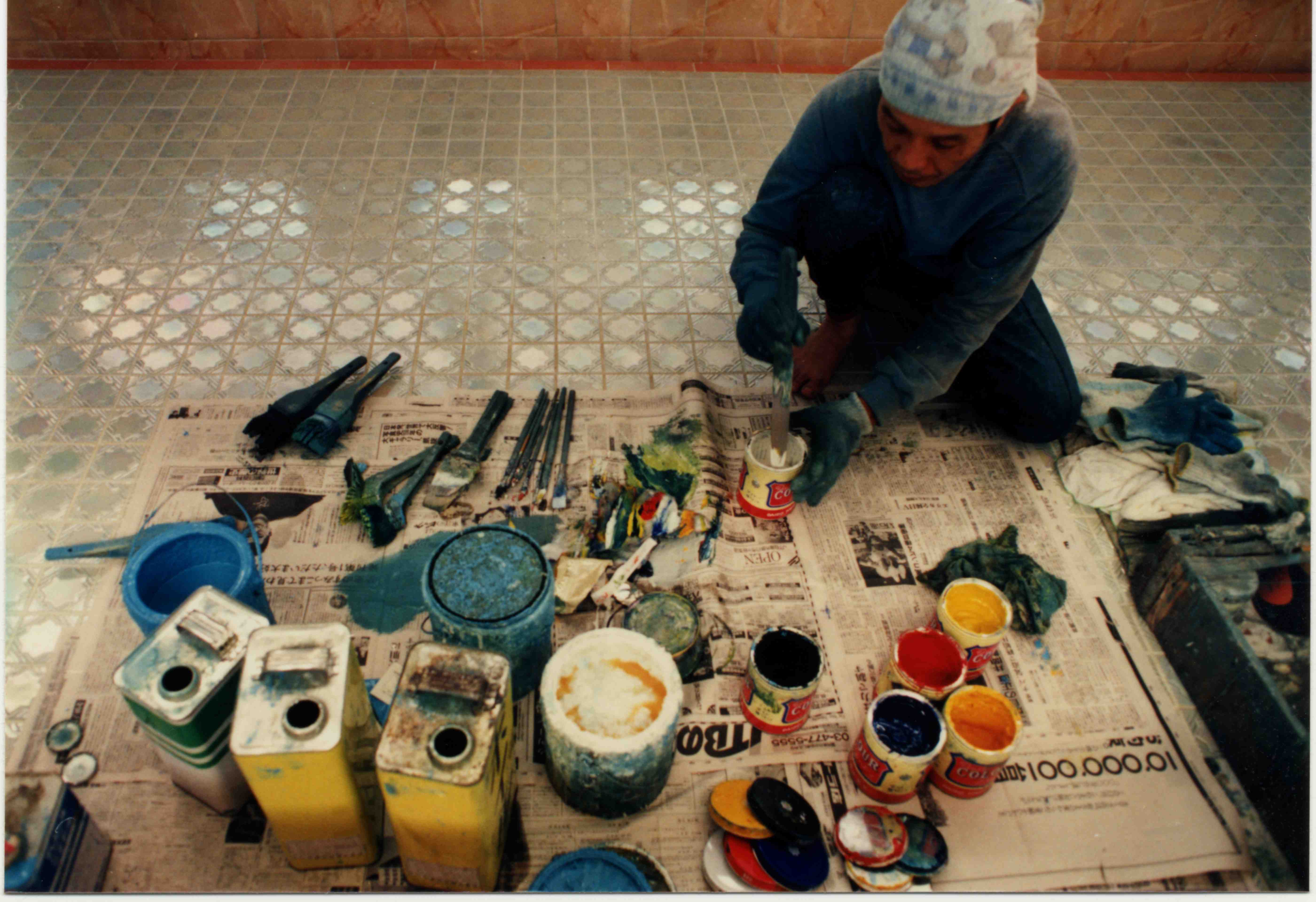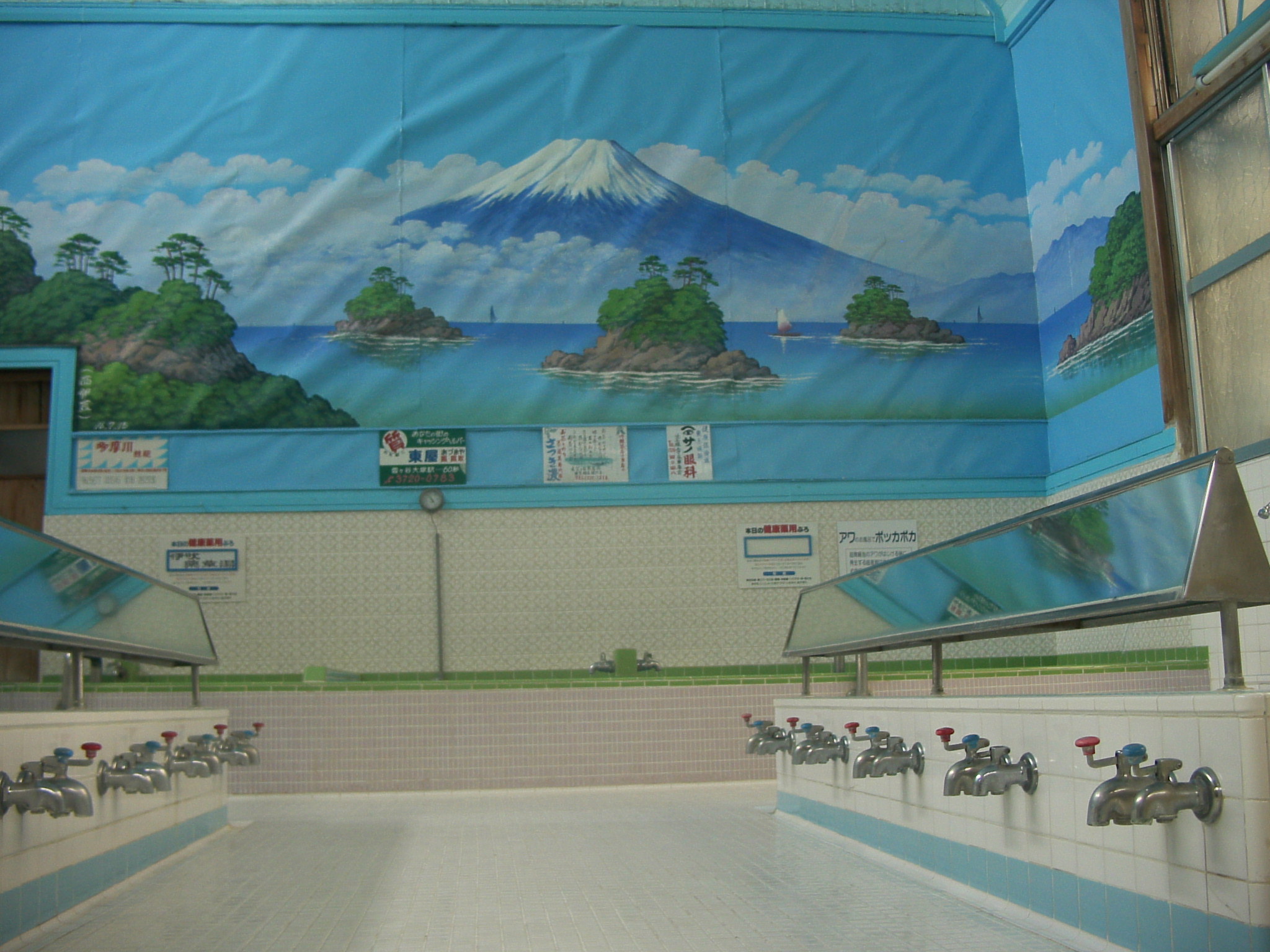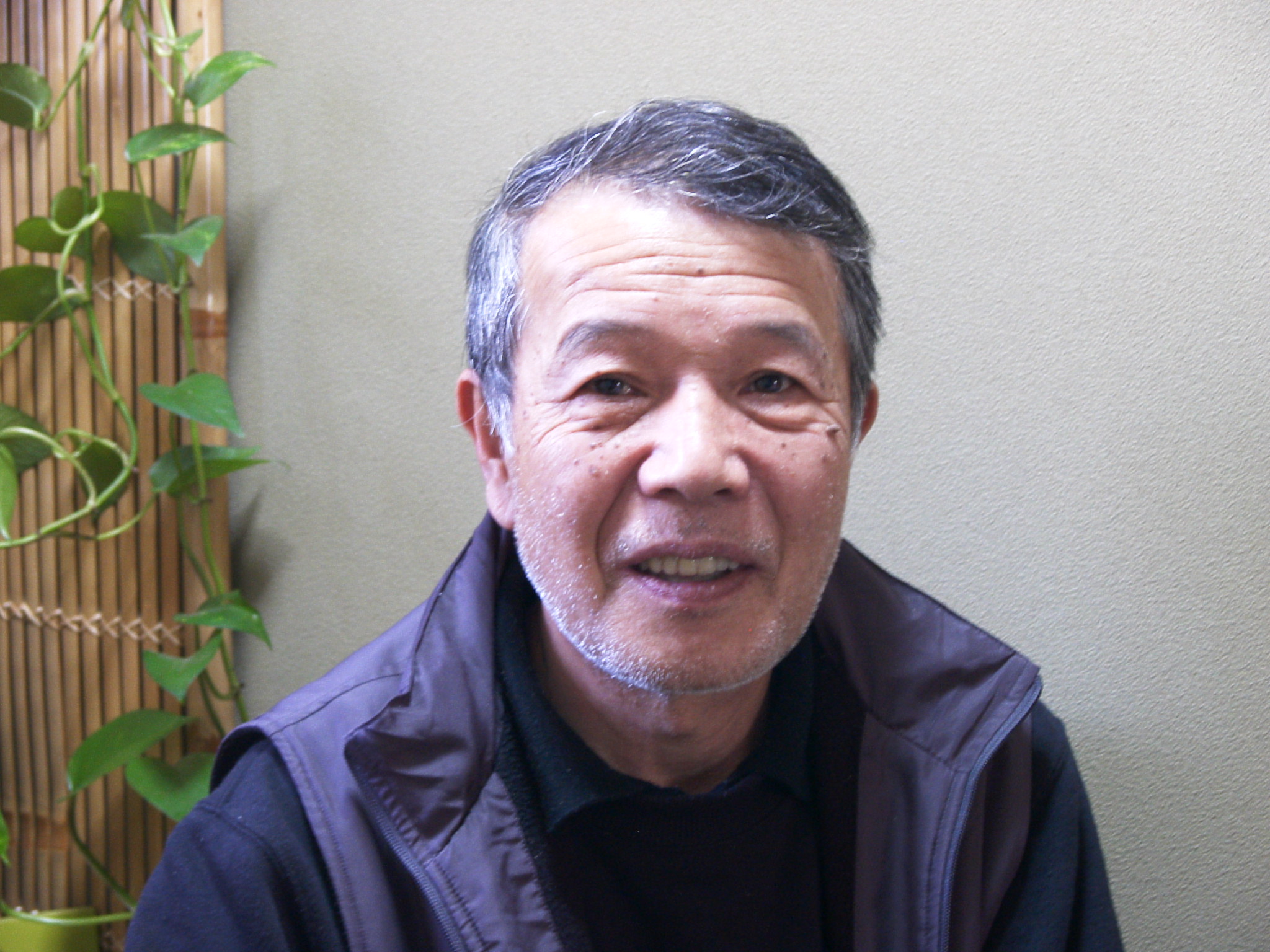This article is a reprint of the article that was published in Daily Yomiuri on July 21, 2005. This article is reprinted upon the agreement with Daily Yomiuri.
Wataru Doi / Special to The Daily Yomiuri
Huge wall paintings of Mt. Fuji are a traditional fixture at Japanese bathhouses. People love to bathe at the foot of the famous mountain or with other wellknown landmarks surrounding them.
These paintings, named penki-e after the Japanese word for the industrial paints artists use to create the huge murals, have been around for more than 90 years and have survived wars and depressions. An important part of Japanese pop art history, they are now in danger of disappearing.
During their heyday, more than 2,000 sentos, or public bathhouses, existed in Tokyo, and many of them had penki-e paintings on their walls. But now that most homes have their own bathtubs, the number of sentos has decreased to about 1,100, and penki-e are on the verge of disappearing.
"I hate to say this, but this art is destined to disappear. Nobody can prevent it," says professional penki-e painter Kiyoto Maruyama. "All I can do is paint as many works as possible for the rest of my life."
Maruyama has devoted 50 years of his life to painting the murals, and he is the most senior among the three remaining penki-e painters in Tokyo today.
Penki-e was born at Kikai-yu, a sento in Kanda Sarugakucho, Chiyoda Ward. When the owner built an annex in 1912, he wanted something fun for children so he commissioned an artist to decorate the wall with a painting. Previously, it had been usual for advertising agencies to sponsor paintings on sento walls in return for free advertising space.
Other famous sightseeing places featured in murals include the Inland Sea between Shikoku and Honshu, Onuma Park in Hokkaido, and Matsushima in Miyagi Prefecture. In the past, Japanese were not rich enough to travel, but bathers could be transported to faraway places by looking at the paintings. There was even one bathhouse with Mt. Everest on its wall.
What makes the penki-e painting method stand out from other painting methods is that the artists have to work under severe conditions. They start work early in the morning and have to finish before the bathhouse opens, usually at 5 p.m. So
the painter only has about eight hours to complete a large painting, usually about 13 meters wide. Not only do the painters have to work fast, they also have to work in extremely hot and humid conditions.
"It looks easy, but you need special techniques to do penki-e," Maruyama explained. "First of all, fabric is laminated onto the wall where the mural is to be painted. Then we smooth the surface with glue, and seal the undercoating and paint over it. Finally we paint a picture, and dry it."
Most of the time is spent preparing the area and drying the painting. Only two or three hours are actually spent painting. "This is one of the terrific things about penki-e painting," emphasized Shinobu Machida, a researcher of popular culture and pioneer of sento research. "No other art can create such a big picture in such a short time."
In 2002, Machida organized a penki-e exhibition at the Mitaka City Arts Center. During the exhibition, the three surviving painters--Toshimitsu Hayakawa, Morio Nakajima and Maruyama--all created murals in front of the visitors. "They finished large paintings in 2-1/2 hours in front of an audience of 200 people. It was amazing," Machida said.
The conditions in which the painters create their murals are sometimes dangerous.
"I once accidentally fell from the ladder into a bathtub filled with boiling water. Sentos usually have boiling water that is cooled right before they open. I was severely burned," Maruyama remembered.
Photos by Wataru Doi
Myojinyu in Ota Ward, Tokyo, is decorated
with Mt. Fuji,
which Kiyoto Maruyama painted.
Legendary painter Mr. Maruyama.

Mr. Maruyama prepares paints
for his coming work
(courtesy by Mr. Maruyama, took in 1988)
Maruyama says penki-e painters must have a strong sense of color and design, as well as proficient technique.
"We usually choose light colors because it makes people happy. Sentos are a place to relax. Bright green, the color of May or June, is appropriate. Winter colors are not suitable because they depress people. Water is a must in any form--sea, lake, or river--because blue gives brightness to the picture," he said.
Though there is variety in the composition of penki-e, most of the paintings make Mt. Fuji their center. Machida visited 3,000 public bathhouses around the country and found that more than 90 percent of penki-e chose Mt. Fuji as their subject because customers liked it.
Formerly, painters used brushes to paint the sky, but Nakajima started using a roller and found it shortened the time it took to do the paintings.
Machida stresses that penki-e is important in terms of art history.
"It adopted Western techniques, which were introduced in the late Edo period. It used light and shade to give contrast," he said.
The technique is called shadow method, which the versatile and multitalented Hiraga Gennai (1728-1779) introduced into Japan.
Shadow method gives the painting various shades of color and makes it three dimensional, in contrast to the traditional Japanese method in which the painter drew an outline and then filled it in with color.
"Before that [shadow method], pictures were flat. The technique was necessary because people viewed the painting through the steam of the bathtub. It needed to look rough up close, but clear from a distance," Machida explained.
According to Machida, the shadow method was adopted in other forms of pop art, such as traditional Japanese picture-card shows and brochures for circus sideshows.
"The circus sideshow brochures in particular used a beautiful, specialized technique. In the past there were a few good painters in Kokura, Fukuoka Prefecture, but they passed away and nobody can duplicate the technique today. Penki-e painters follow their technique and have preserved it up until now," Machida said.
Tough to become penki-e painter
Maruyama says becoming a penki-e painter is not easy. "During the first three years, apprentices are allowed to paint only the sky blue. Many of them quit at this point. Apprentices watch the process of painting and learn from the master. Then, they are allowed to paint sides, clouds and, eventually, the whole picture. Usually, it takes six years to get to that point."
Maruyama began his career when he was 18. At that time, every penki-e painter belonged to an advertising agency. Maruyama loved art and joined Haikei Kokoku-sha, an advertising agency that his uncle, Kikuo Maruyama, managed. The uncle was a legendary penki-e painter, and the young Maruyama became his assistant.
"I learned a lot from him," Maruyama reminisced. "For instance, bathhouse mural painters usually did not draw rivers, because rivers are narrow and winding, and don't express a good mood and brightness. But my uncle was very good at drawing rivers."
Maruyama started painting on his own when he was 24.
Sento paintings have to be replaced once a year, because they wear off quickly in the hot steam and humidity. But the original painting is not stripped away from the wall, rather a new one is painted over it.
"First, we produce drawings with chalk. Then we make rough coloring, blue for the sky, brown for rock, and green for grass. In the end, we draw the details and finalize it," Maruyama explained.
Maruyama said the days after the Tokyo Olympics were the best time to be a penki-e painter. He worked six days a week and sometimes worked at two bathhouses in the same day. The economy was good and sentos renewed their paintings every year. There were dozens of painters working in Tokyo at the time.
Now sentos cannot afford to renew the paintings annually, and Maruyama has only four or five jobs a month. He sometimes gets a job in a private house or more recently spas, but not so often.
"My son asked me how to become a penki-e painter, but I don't want to encourage him because he won't be able to make a living. Today is a difficult time to be a penki-e painter," Maruyama said sadly.
As a sento afficionado, Machida is trying to preserve the art.
"It was a question from an Australian friend of mine that took me to thousands of sentos. I had tried to introduce him to something traditionally Japanese, and took him to a sento. He asked me why it looked like a temple, but I couldn't answer. Then I realized many sentos were dilapidated and decided to do some research.
"I sometimes plan sento tours to look at penki-e. I arranged one in June." Machida will take Setagaya Art Museum curator interns on a sento tour in July. He says he wants them to learn about architecture and penki-e paintings. Machida also has a private collection of penki-e.
According to Machida, on average 40 public bathhouses close every year. "Many of them have penki-e. I assume there are fewer than 200 public bathhouses that display penki-e. Some of them do not get new ones for seven or eight years because they cannot afford it," he said.
Machida recommends Daikoku-yu in Kitasenju, Adachi Ward, and Myojin-yu in Yukigaya, Ota Ward, for the best paintings.
"But please remember that the condition of penki-e change rapidly and they may not be in the same, good condition in the future."
The painting at Myojin-yu is by Maruyama, painted last July. It shows Mt. Fuji viewed from Nishi-Izu, Shizuoka Prefecture. He painted this during the Bon festival and had longer than usual to complete it.
"He worked until 8 in the evening, and put a lot of effort into this painting," an employee at Myojin-yu said.
Hayakawa has also done a painting for Myojin-yu, of a violent wave breaking against a huge rock. In contrast to Hayakawa, Maruyama's work is gentle and has depth and expanse of space. As its customers age, Myojin-yu chooses Maruyama's work because it is more relaxing for the elderly.
On sunny days, Mt. Fuji was once a common view from every hilltop in Tokyo. Now, it is usually hidden in smog or behind soaring skyscrapers. Penki-e of Mt. Fuji are also disappearing from neighborhood sentos, but hopefully they will live on in people's memories.
(This article was written and posted on July 21, 2005)

